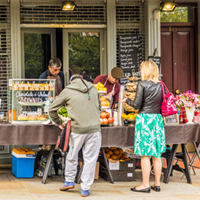Moving to Siargao, Philippines
Last updated on Sep 16, 2024
Summary: Moving to Siargao, Philippines? Expats talk about what you need to know before moving to Siargao.
What do I need to know before moving to Siargao?
When we asked people what advice they would give someone preparing to move to Siargao, they said:
"Expats moving to Siargao should be aware that the island is known for its surfing, with the peak season running from August to November. English is widely spoken in Siargao, making communication relatively easy for expats. The cost of living in Siargao is relatively low compared to Western countries, but higher than in other parts of the Philippines. Healthcare facilities on the island are basic, so for serious medical conditions, one would need to travel to larger cities like Cebu or Manila. Expats should ensure they have comprehensive health insurance that covers medical evacuation. Siargao has a tropical climate, with a dry season from March to October and a wet season from November to February. The island is prone to typhoons, especially during the wet season. The island's infrastructure is still developing, so power outages can be common and internet connection can be unreliable. Expats should also be aware that Siargao is a remote island, and while it has an airport, flights can be limited and often get cancelled due to bad weather. The local culture in Siargao is laid-back and friendly, and expats are generally welcomed by the local community. However, it's important to respect local customs and traditions. Siargao has a growing expat community, with many foreigners owning businesses on the island. However, foreigners cannot own land in the Philippines, but they can own condominium units or townhouses, or they can lease land. Public transportation on the island is limited to tricycles, motorcycles, and jeepneys, so many expats choose to rent or buy a motorbike. Finally, Siargao is a beautiful island with stunning landscapes, clear waters, and rich biodiversity, making it a paradise for nature lovers and outdoor enthusiasts," commented one expat who made the move to Siargao.
How do I find a place to live in Siargao?
We asked expats how they chose their neighborhood and found a place to live. They answered:
"Finding a place to live in Siargao involves several steps. First, you need to determine your budget and the type of accommodation you're looking for. This could range from a simple beach hut to a luxury villa. Next, research the different areas of Siargao. The island is divided into several municipalities, each with its own unique characteristics. General Luna is the most popular area, known for its surfing spots and vibrant nightlife. If you prefer a quieter environment, consider places like Pilar or Dapa. Once you have an idea of where you want to live, start looking for available accommodations. Websites like Airbnb, Booking.com, and Agoda can be useful for this. They allow you to filter results based on your preferences and read reviews from previous guests. Another option is to join local Facebook groups or forums where people often post available rentals. Examples include "Siargao Island Classifieds" and "Siargao Community Classifieds". If you're planning to stay long-term, consider hiring a local real estate agent. They can help you navigate the local property market and negotiate contracts. Before making a decision, it's recommended to visit Siargao and see the places in person. This allows you to get a feel for the area, check the condition of the property, and meet potential neighbors. Finally, once you've found a place you like, make sure to read the contract carefully before signing. Check the terms and conditions, including the rent, deposit, length of stay, and what's included in the price. If everything is in order, you can then proceed to secure your new home in Siargao," said one expat in Siargao.
What is a typical expat home or apartment like in Siargao?
"A typical expat home or apartment in Siargao, is often a blend of modern and traditional Filipino design. The homes are usually spacious, with open floor plans to allow for natural light and air circulation. They often feature large windows and doors that open onto private balconies or patios, offering stunning views of the surrounding tropical landscape. The interiors are typically furnished with locally sourced materials, such as bamboo, rattan, and other tropical hardwoods, giving the homes a warm and inviting feel. The kitchens are usually fully equipped with modern appliances, while the bathrooms often feature walk-in showers and sometimes even outdoor showers. Many expat homes in Siargao also come with private gardens, where residents can grow their own tropical fruits and vegetables. Some even have private pools or direct access to the beach. Despite the luxurious features, these homes often blend seamlessly into the natural environment, thanks to their use of local materials and sustainable design principles. In terms of location, expat homes in Siargao are often situated in quiet, residential areas, away from the hustle and bustle of the main tourist spots. However, they are still conveniently located near local amenities, such as markets, restaurants, and surf spots. Overall, a typical expat home in Siargao offers a comfortable and luxurious living experience, while still allowing residents to enjoy the natural beauty and laid-back lifestyle of the island," explained one expat living in Siargao, Philippines.
What is the average cost of housing in Siargao?
If you are thinking about moving to Siargao, cost of living in probably a key consideration. Expats commented about the cost of housing:
"The average cost of housing in Siargao can vary greatly depending on the location and type of housing. For a simple native house or cottage, the monthly rent can be quite affordable. However, for more luxurious villas or beachfront properties, the cost can be significantly higher. On average, you can expect to pay a moderate amount for a decent house or apartment in Siargao. It's also worth noting that buying property can be a complex process for foreigners due to local laws and regulations," said one expat who made the move to Siargao.
Should I buy or rent a home in Siargao?
If you have not spent a lot of time in Siargao, you should rent before even thinking about buying. We asked expats there about the buy vs. rent decision:
"The decision to buy or rent a home in Siargao, largely depends on your personal circumstances, financial situation, and long-term plans. If you plan to stay in Siargao for a long period, buying a home could be a good investment. Owning a property allows you to build equity over time and could potentially provide a source of income if you decide to rent it out. On the other hand, renting a home in Siargao offers more flexibility. It's a good option if you're not sure how long you'll be staying or if you prefer not to have the responsibilities that come with homeownership, such as maintenance and repairs. Renting can also be more affordable in the short term, as it doesn't require a large upfront payment like a down payment on a house. It's also important to consider the local real estate market in Siargao. If property prices are high and continue to rise, buying a home could be a smart financial move. However, if prices are stagnant or falling, renting might be a safer choice. Lastly, consider your lifestyle preferences. If you value stability and the ability to customize your living space, buying a home could be the right choice. But if you prefer the freedom to move around and not be tied down, renting might be more suitable. In conclusion, both buying and renting a home in Siargao have their pros and cons. It's crucial to weigh these factors carefully and consider seeking advice from a real estate professional or financial advisor before making a decision," remarked one expat who made the move to Siargao.
What should I pack when moving to Siargao?
We asked people living in Siargao to list three things they wish they had brought and three they wish they had left behind. They responded:
"When moving to Siargao, you should pack lightweight and breathable clothing due to the tropical climate. Include swimwear, as the island is known for its beautiful beaches and surfing spots. Don't forget to pack a good quality sunscreen, insect repellent, and a hat to protect yourself from the sun. Bring along a sturdy pair of sandals suitable for walking on the beach and a pair of sneakers for exploring the island. Pack a rain jacket or umbrella, as the weather can be unpredictable. If you plan on surfing, you might want to bring your own surfboard and gear, although these can also be rented on the island. Pack your necessary toiletries, but keep in mind that Siargao is trying to be an eco-friendly island, so consider bringing biodegradable products. Don't forget to bring any necessary medications, as well as a basic first aid kit. Pack your important documents such as passport, driver's license, and any necessary visas or permits. Lastly, bring a good camera to capture the beauty of the island, and a reusable water bottle to stay hydrated," said one expat who made the move to Siargao.
 Remitly
RemitlyLearn More
Send money online for what matters most. We make international money transfers easier than ever. Choose how and when you send, with great exchange rates and low fees.
 Remitly
RemitlySend money online for what matters most.
We make international money transfers easier than ever. Choose how and when you send, with great exchange rates and low fees.
Learn More
What cultural faux pas should I try to avoid making in Siargao?
We asked people in Siargao if they could share any humorous cultural blunders they commited. For new expats, keep in mind that these incidents are an inevitable part of expat life. Learning to laugh about them is the key!:
"When visiting Siargao in the Philippines, it's important to respect local customs and traditions. Avoid making negative comments about the country, its people, or its culture, as Filipinos are very proud of their heritage. Do not disrespect religious beliefs or practices. The Philippines is predominantly Catholic, and religious activities are taken seriously. Avoid public displays of affection, as they are considered inappropriate and disrespectful. Do not point with your fingers, as this is considered rude. Instead, use your lips to point or gesture. Avoid raising your voice or showing anger in public. Filipinos value harmony and prefer to avoid confrontation. Do not litter or damage the environment. Siargao is known for its natural beauty, and locals take great pride in preserving it. Avoid being overly casual or informal when addressing elders or people in positions of authority. Use honorifics like "po" and "opo" to show respect. Do not refuse food or drinks offered to you during social gatherings or home visits. It's considered impolite to decline hospitality. Avoid wearing revealing clothing, especially in religious or traditional settings. Dress modestly to respect local customs. Do not be late for appointments or meetings. Filipinos value punctuality and consider it a sign of respect. Avoid discussing sensitive topics like politics or controversial issues. Filipinos prefer to keep conversations light and positive. Lastly, do not forget to say "Salamat" (Thank you) as Filipinos appreciate politeness and good manners," remarked one expat in Siargao, Philippines.
About the Author
 Betsy Burlingame is one of the founders of Digital Nomad Exchange and the Founder and President of Expat Exchange. She launched Expat Exchange in 1997 as her Master's thesis project at NYU. Prior to Expat Exchange and Digital Nomad Exchange, Betsy worked at AT&T in International
and Mass Market Marketing. She graduated from Ohio Wesleyan University
with a BA in International Business and German.
Betsy Burlingame is one of the founders of Digital Nomad Exchange and the Founder and President of Expat Exchange. She launched Expat Exchange in 1997 as her Master's thesis project at NYU. Prior to Expat Exchange and Digital Nomad Exchange, Betsy worked at AT&T in International
and Mass Market Marketing. She graduated from Ohio Wesleyan University
with a BA in International Business and German.
Some of Betsy's articles include 12 Best Places to Live in Portugal, 7 Best Places to Live in Panama and 12 Things to Know Before Moving to the Dominican Republic. Betsy loves to travel and spend time with her family. Connect with Betsy on LinkedIn.

Get a quote in 2 minutes from our partner, Cigna Global Health.
Get Quote
![]() Philippines Forum
Philippines Forum
Talk with other digital nomads and expats in Philippines on our Philippines forum - meet people, get advice and help others.
![]() Contribute
Contribute
Help others in Philippines by answering questions about the challenges and adventures of living in Philippines.
Digital Nomads in Philippines offer advice about healthcare, hospital visits, emergency rooms visits, finding a doctor and buying health insurance in Philippines.

 Siargao, Philippines
Siargao, Philippines

